#Irrigation expert
Text
Tucson Irrigation Sprinkler System

Source: https://plumbingservicetucson.blogspot.com/2022/12/tucson-irrigation-sprinkler-system.html
#Irrigation#Sprinklers#Irrigation Sprinkler System#sprinkler irrigation system#Tucson Sprinklers#Tucson drinking water softner#Tucson drinking water system#Whole home Tucson drinking water filters#Water filters#Home water filtration#Home water filers#Irrigation expert#Tucson irrigation experts#Tucson irrigation plumber#Plumber near me
0 notes
Text
What Are Common Irrigation Problems in Mildura and How Can They Be Fixed?
Maintaining effective irrigation systems is crucial for agriculture in Mildura. However, several common issues can affect the efficiency of irrigation works Mildura. Understanding these problems and knowing how to fix them can ensure optimal water use and crop health.
Clogged Nozzles:
Clogged nozzles are a frequent issue. Dirt, debris, and mineral deposits can block water flow, leading to uneven distribution. To fix this, regularly inspect and clean nozzles using a fine needle or brush. Installing filters in your irrigation works Mildura can also prevent clogs.
Uneven Water Distribution:
Uneven water distribution can result from improper system design or wear and tear. Check for leaks, ensure sprinklers are properly aligned, and adjust water pressure. Regular maintenance and system audits can help maintain balanced irrigation works Mildura.
System Leaks:
Leaks cause significant water wastage and affect efficiency. Common causes include damaged pipes and loose fittings. Regularly inspect for visible leaks and listen for hissing sounds. Promptly repair or replace damaged parts to maintain efficient irrigation works Mildura.
Inadequate Water Pressure:
Low water pressure hinders performance and results in insufficient coverage. Causes include clogged filters, leaks, or pump issues. Clean filters regularly, repair leaks, and ensure the pump functions correctly. Proper system design and maintenance prevent pressure-related problems in irrigation works Mildura.
Scheduling Issues:
Improper scheduling leads to overwatering or underwatering, affecting plant health. Use automated controllers to manage watering schedules. Adjust timing and frequency based on weather and soil moisture levels for optimal irrigation works Mildura.
Conclusion:
Addressing common problems such as clogged nozzles, uneven distribution, leaks, low pressure, and scheduling issues is vital for efficient irrigation works Mildura. Regular maintenance and professional help keep your system running smoothly. B & S Earthworks specialises in providing top-notch irrigation solutions tailored to your needs in Mildura. Contact us today for all your irrigation needs.

#irrigation works mildura#irrigation works victoria#irrigation works service mildura#irrigation works service victoria#irrigation works company mildura#irrigation works company victoria#expert irrigation works mildura#professional irrigation works mildura#expert irrigation works victoria#professional irrigation works victoria#b & s earthworks irrigation works#b & s earthworks
0 notes
Text
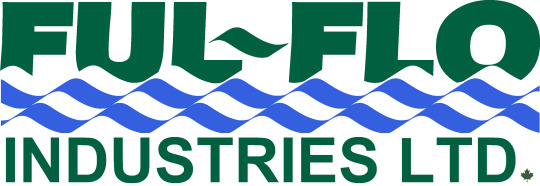
#Fountain & Irrigation Services Experts in Winnipeg & Manitoba | Ful-Flo Industries Ltd#Ful-Flo specializes in fountain services#spray parks#agricultural & golf irrigation. We cover residential & commercial areas in Winnipeg & Manitoba.#Fountains services winnipeg#Fountains repairs manitoba#Agricultural irrigation manitoba#water treatment plants winnipeg#Ful-Flo Industries Ltd. was first incorporated in 1976. Providing irrigation and concrete splash or spray pads in Winnipeg#Manitoba and NW Ontario#Ful-Flo Industries is located on the outskirts of Winnipeg on the north Perimeter Highway just a ½ mile west of Highway#7#keywords:#Golf irrigation winnipeg#Spray pads winnipeg#Article:#Ful-Flo Industries Ltd. offers a warehouse of possibilities regarding the residential/do-it-yourself markets for irrigation in Manitoba. If#Read more#GOLF IRRIGATION#Ful-Flo Industries Ltd. is proud to support the golf course industry with the best product#people and equipment available. From our parts and service counter that will support#Agricultural irrigation winnipeg#AGRICULTURAL IRRIGATION#From its earliest days#Ful-Flo Industries Ltd. has left its mark in the agriculture industry. One of Ful-Flo Industries Ltd.'s major markets is the Manitoba Potat#fountains services manitoba#FOUNTAINS#A fountain conveys elegance and relaxation#while drawing attention to your area of interest It is human nature to be drawn to the beautiful fountain on your area#Spray pads manitoba
0 notes
Text
Irrigation and Lighting Experts - Plant Specialists
If you are looking for irrigation and lighting experts there are several companies that specialize in these services. Expert Irrigation & Outdoor Lighting has over 30 years of experience providing irrigation and landscape lighting systems for homeowners and businesses in Cincinnati and Northern Kentucky. They offer a full suite of irrigation and outdoor lighting services, including installation, maintenance, and repair. They offer products and services that can help reduce water and electric bills through innovative technologies. They have highly trained and certified staff who can assist with the design, installation, service, and repair of irrigation and lighting systems. Their services aim to enhance property value, reduce maintenance tasks, and keep landscapes looking great day and night.

0 notes
Text
Garden designers in London are crucial in creating a peaceful and practical space at home.
Garden designers in London can help you create a focal point with little effort. Garden designers in London also offers some ideas to create other focal points.
Garden designs, Garden Irrigation, Landscape Gardener, Landscaping, Landscaping Company
0 notes
Text
Agricultural & Greenhouse Industry Experts
Keeping Your Business Flowing
Over the years, our staff has traveled worldwide to research and purchase products that benefit the agricultural needs of our customers. We now import from Italy, the Netherlands, France, Germany, China, India, and the United States. Our service personnel has attended many training workshops to enable us to service all of our marketed material. We will not sell products that we cannot service in-house.
Experienced in a Variety of Industries
As proven agricultural equipment experts, when a customer phones into any of our locations, they receive immediate information on the product they are inquiring about. If the salesperson is unfamiliar with their request, they can rely on one of the other experienced sales team members to answer. If it is not a product that we are familiar with, we have the resources to source their request and provide them with their product.
WaterTec Irrigation Ltd. was formed, in February of 1998, by five men with over 80 years of agricultural equipment expertise, sales, service, and purchasing. Over the years, WaterTec has expanded to locations in Langley, Williams Lake, and Lynden.
At present, WaterTec employs 30 full-time sales, service, and support staff. The goal then, and now, has been to provide our customers with the best material and service at the best possible price. WaterTec Sales & Service’s staff have the highest levels of training in the irrigation industry. The WaterTec management team is focused on empowering our staff to be the best they can be in order to better help customers.
Langley, BC, Canada
23160 72 Ave
Langley, BC, Canada V2Y 2K2
604–305–4467
855–902–7520
604–882–7408
https://www.watertecna.com/
Williams Lake, BC, Canada
Unit 1, 1075 Murray Dr.
Williams Lake, BC, Canada V2G 4K8
250–398–7757
855–398–7757
250–398–7751
https://www.watertecna.com/
Lynden, WA USA
177 Birch Bay Lynden Rd.
Lynden, WA 98264–9456
360–230–7634
866–411–9628
360–393–4931
https://www.watertecna.com/
1 note
·
View note
Photo

Why do i need a Licensed professional Engineer
Improper repairs to drainage, irrigation or foundation systems can actually lead to more costly foundation problems! To avoid multiple bids, and conflicting opinions for the best foundation solution, contact TEC at the first sign of concern. For more information visit:- https://thomasengineeringdfw.com/
0 notes
Text
A UN report says 96 percent of Gaza’s population is food insecure and one in five Palestinians, or about 495,000 people, is facing starvation.
Satellite images analysed by Al Jazeera's digital investigation team, Sanad show that more than half (60 percent) of Gaza's farmland, crucial for feeding the war-ravaged territory’s hungry population, has been damaged or destroyed by Israeli attacks.
Israel has killed at least 37,900 people and injured 87,000 others in bombings, by destroying healthcare that could have saved them, and by starvation.
[...]
In February, the UN Food and Agriculture Organization (FAO) assessed the agricultural and livestock damage across Gaza.
They found significant damage to:
- 626 wells
- 307 home barns
- 235 chicken farms
- 203 sheep farms
- 119 animal shelters
In addition, they estimated that 27 percent - 339 out of 1,277 hectares (3,156 acres) - of Gaza’s greenhouses were damaged by Israel’s assault.
Experts say military hardware and bombs have damaged Gaza's fertile soil for many years.
“There will be years of destruction because of the material used in the explosives and phosphorus bombs used there, this will affect the land and water in the long term,” agricultural consultant Saad Dagher told Al Jazeera.
2 July 2024
Geneva Convention, Protocol I, Article 54 - Protection of objects indispensable to the survival of the civilian population
1. Starvation of civilians as a method of warfare is prohibited.
2. It is prohibited to attack, destroy, remove or render useless objects indispensable to the survival of the civilian population, such as foodstuffs, agricultural areas for the production of foodstuffs, crops, livestock, drinking water installations and supplies and irrigation works, for the specific purpose of denying them for their sustenance value to the civilian population or to the adverse Party, whatever the motive, whether in order to starve out civilians, to cause them to move away, or for any other motive.
418 notes
·
View notes
Text
OKAY it has been a day of being sad and panicky. Time to move.
Yesterday, I made a post detailing the cdc announcement that there will no longer be an isolation requirement for covid. If you are one of the thousands of people rightfully raging in my notes, here's some steps to focus on.
We're not gonna give up. I've seen quite a few comments with things like 'what's the point', 'why should I even try anymore' etc etc and what we're not gonna do is give them what they want! It helps the eugenics cause to be apathetic and listless. We've made it this far, we will continue to make it. I know it's hard, but I am at least right here with you. Give yourself whatever time you need to grieve, and then I need you to get up.
If you have stopped masking for any reason, or you haven't upgraded to a respirator style mask, now is the time to change or start. From now on, we will be living in a country where you could assume there are multiple covid positive people in the room with you at all times. Surgical masks will not handle that load, and cloth masks will be even less effective at that point. Obviously, this is an unprecedented situation we're putting these masks in, and I'm not gonna sit here and pretend to be an expert that can tell you with certainty that even respirators will hold up with this amount of viral load for a long period of time, but it's the best and strongest tool we have. I'm considering using my p100 more, so that's always something to consider as well (and they make you look like a cool raver when you wear them!!!).
You can buy all sorts of masks here, there's more links in the comments of my original post, and most states have their own mask blocs. To find them, go to Instagram and type "[your state] mask bloc". Here is a google doc of verified advocacy groups and mask blocs all across the country
here is a diy fit test kit you can buy for $30 (unfortunately they are sold out right now. shocker.)
PLEASE remember to take a layered response in these times. Masks are not the only tool in our arsenal. PLEASE for the love of God keep up with your vaccinations. Make a corsi-rosenthal box or buy a high quality air purifier if you can afford it--at the very least our homes can be safe havens (you can even put a hepa filter on your furnace!!!! And in your car too!!!!!). Use CPC Mouthwash, nasal irrigation, and nasal sprays like this one. Make it a routine: you come home, you shower, you brush your teeth, you rinse your nose, you change your clothes. And, like I said in another one of my posts, DO NOT TAKE OFF THE MASK.
3. If you would like an outlet for your rage and you're into calling your reps, feel free to calmly but firmly let the cdc have it at these numbers!!!!!
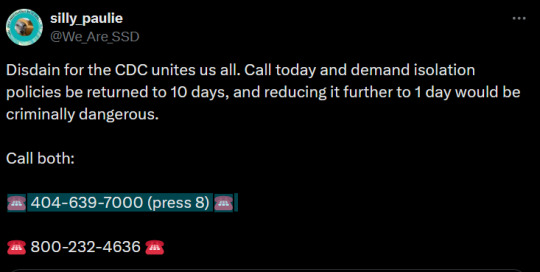
[alt text: a tweet by user silly_paulie that reads:
"Disdain for the CDC unites us all. Call today and demand isolation policies be returned to 10 days, and reducing it further to 1 day would be criminally dangerous.
Call both:
404-639-7000 (press 8)
800-232-4636"
end text.]
4. If you need more outlets for your rage, I STRONGLY encourage you to get involved with your local union. Moreso than calling the CDC, tbh. I've seen multiple comments telling people just to lie about your symptoms to get more sick time off, but since there's no legal precedent to allow employees sick time for covid, all that's gonna do is get people fired. I truly believe in my lefty heart that the ONLY way we're getting anything close to mitigation is through labor rights. Even the standard for the fucking flu is 3 days, and that's nowhere near as contagious or disabling as covid. I say this as a high risk person with a neuromuscular disability: covid is an intersectional issue, but where we have the most leverage to get what we need is through labor rights.
It is NOT safe for workers to be working while ill with a Level 3 Biohazard (same as TB and the FUCKING PLAGUE. Seriously we have more regulations around fucking lice)
It is NOT safe to willfully EXPOSE your employees to a Level 3 Biohazard
It is NECESSARY for all employees to be allowed up to 10 days to recover fully from Covid-19, in order to avoid possible further injury from or hospitalization
You will NOT die or be disabled for the sake of the wealthy!!!!!
(and while you're at it, ask for better air filtration too!!!! At least 5 air changes an hour, MERV-13 air filters!! Then we won't have to constantly worry about virus bs and policy changes in the first place!!!!)
5. Closing statements. Nothing has changed with covid, this is just policy. Covid still isn't magic, she still has to get in you before she can do damage--mask up, arm your home with clean air, and don't let her. It's always worse toward the end. This is not the time to give up, it's time to dig in your heels and get to work. There are so many good things happening with covid. They are finding encouraging treatments for long covid. Finally, after years of nothing, a new prophylactic for the high risk was submitted for emergency use to the FDA, and it looks like this time it's built to last against new mutations. Covid is here to stay for the rest of our lives, but the real science hasn't given up on taking the worst of its teeth out. We WILL get to the point where the extreme fear of catching covid is nothing but a bad memory for EVERYONE. All I need you to do is commit to the belief that you're gonna survive long enough to be in that moment with the rest of us.
Now stay safe, and give em hell!!!!!
#covid 19#covid safe#covid advocacy#covid is not over#mask up#danger days: truffula flu simulator#truffula flu survival guide
316 notes
·
View notes
Text
To drive through the West Bank is to pass through a nature-scape of browns, oranges and reds. It’s rolling hills scattered with wild olive tree groves and crop rows, and views of sprawling cities in the distance, slightly obscured by the blur of a faint haze. That backdrop changes suddenly when confronted with an Israeli settlement. Desert shades are swapped for emerald greens, and olive trees for pine. Swaths of farmland suddenly host swimming pools and soccer fields, and dry farmland dry becomes lush greenery.
This jarring polarity is a constant reminder of the Israeli occupation, says Fokha, whose village of Tubas is encircled by such settlements. “They have all these things, and we’ve been stripped of our way of life,” he says. “All I want is enough water to sustain my family and my land.”
It’s also the most effective way to permanently damage the Palestinian food system, say multiple experts.
Given the dry conditions, water access long been weaponized in the conflict. So much so, that the Oslo Accords sought to address it. It stipulated that for an interim period of five years, Israel would gain access to 80 percent of the water pumped from the West Bank and Palestinians would get the remaining 20 percent. It also limited the amount of water Palestine could drill from the shared mountain aquifer, while allowing Israel unlimited access, and required Israel sell a pre-determined amount of water to Palestinians annually. B’tselem calls what’s transpired since a “largely manmade” water shortage that allows Mekorot, the state-run Israeli water company, to control the entire grid, giving preferential access to settlers while while hundreds of thousands of Palestinians live without for weeks every year.
Palestinian farmers all over the West Bank can no longer survive as a result. Fokha, who has been working the same land since he was 18 years old, only gets enough access to water to grow for one season—August to March—which halves his yield. The soil’s suffered from the droughts, so it can no longer grow watermelon, potatoes, and certain types of cucumber, he says. Yosef Salmon has been a farmer in Beit Jala, an area outside of Bethlehem, for nearly 45 years. He says there used to be five water springs in the Makhrour Valley. Today, he can access only one, he says. His neighbor, Basem, who asked to keep his last name private, couldn’t irrigate half his crops last year, so he lost money and couldn’t live off the anticipated harvest. “Without water, we can have no progress. Without water we can’t do anything. It is life,” Basem says.
—Carly Graf, "Food Is the First Frontier of the Israeli-Palestinian Conflict," 2019.
175 notes
·
View notes
Text
In the late 18th century, [...] Lahaina carried such an abundance of water that early explorers reportedly anointed it “Venice of the Pacific”. A glut of natural wetlands nourished breadfruit trees, extensive taro terraces and fishponds that sustained wildlife and generations of Native Hawaiian families.
But more than a century and a half of plantation agriculture, driven by American and European colonists, have depleted Lahaina’s streams and turned biodiverse food forests into tinderboxes. Today, Hawaii spends $3bn a year importing up to 90% of its food. This altered ecology, experts say, gave rise to the 8 August blaze that decimated the historic west Maui town and killed more than 111 people.
“The rise of plantation capital spawned the drying of the west side of Maui,” said Kamana Beamer, a historian and a former member of the Hawaii commission on water resource management [...].
---
[S]ugar and pineapple white magnates began arriving on the islands in the early 1800s. For much of the next two centuries, Maui-based plantation owners like Alexander & Baldwin and Maui Land & Pineapple Company reaped enormous fortunes, uprooting native trees and extracting billions of gallons of water from streams to grow their thirsty crops. (Annual sugar cane production averaged 1m tons until the mid-1980s; a pound of sugar requires 2,000lb of freshwater to produce.)
Invasive plants that were introduced as livestock forage, like guinea grass, now cover a quarter of Hawaii’s surface area. The extensive use of pesticides on Maui’s pineapple fields poisoned nearby water wells. The dawn of large-scale agriculture dramatically changed land practices in Maui, where natural resources no longer served as a mode of food production or a habitat for birds but a means of generating fast cash, said Lucienne de Naie, an east Maui historian [...].
“The land was turned from this fertile plain – with these big healthy trees, wetland taros and dryland crops like banana and breadfruit – to a mass of monoculture: to rows and rows of sugar cane, and rows and rows of pineapple,” she said.
---
The Great Māhele of 1848, a ground-breaking law that legitimized private land ownership, laid the ground for big developers to hoard water for profit, said Jonathan Likeke Scheuer, a water policy consultant and co-author of the book Water and Power in West Maui. [...] [T]he creation of private property allowed agricultural corporations to wield “political and ultimately oligarchic power” over elected officials. In 1893, a group of sugar magnates and capitalists overthrew the Hawaiian Kingdom’s Queen Liliuokalani, paving the way for the US to annex Hawaii five years later. Sanford Ballard Dole, a cousin of Dole Plantation’s founder, served as the first governor of Hawaii.
When the last of the sugar companies closed in 2016 [...], Scheuer said, the farms were purchased by large investors for real estate speculation and left fallow, overrun with invasive grasses that became fuel for brush fires. Developers [...] took control of the plantations’ century-old irrigation ditches and diverted water to service its luxury subdivisions. In doing so, it left scraps for Indigenous families who lived downstream. [...] [O]n Maui, 16 of the top 20 water users are resorts, time-shares and short-term condominium rentals equipped with emerald golf courses and glittering pools [...].
---
Text by: Claire Wang. "How 19th-century pineapple plantations turned Maui into a tinderbox". The Guardian. 27 August 2023. [Bold emphasis and some paragraph breaks/contractions added by me.]
270 notes
·
View notes
Text
Today, we're doing part of the selection process for saving seed from kale. Ideally, when they bloom next year, I'll have winnowed my population down to about 25 to 50 plants.
Already, I've selected for:
Ability to sprout after more than a year of poor storage conditions
Vigor in overcrowded situations (because I thought it wouldn't have a good germination rate... turns out they're very resilient seeds!)
Strong root systems capable of getting water even without irrigating, even in hotter and dryer conditions than normal (they're in a hoop house)
Now, I'm selecting for leaf shape and resistance to invertebrate grazing pressure:

I'm working from a grex, which in the context that I know it from, is a population of plants that have a lot of genetic diversity, with a lot of expressed variety, which can either be maintainedor be used to select a new variety. You can make a grex by picking a few varieties of kale, for example, letting them cross, and then choosing to maintain a certain level of diversity through the following generations.
We've decided that we like the broader, flatter, less frilly leaves, so I'm thinning out all the frilly-est plants. Here's post thinning:

And here's the day's kale for breakfast and lunch:
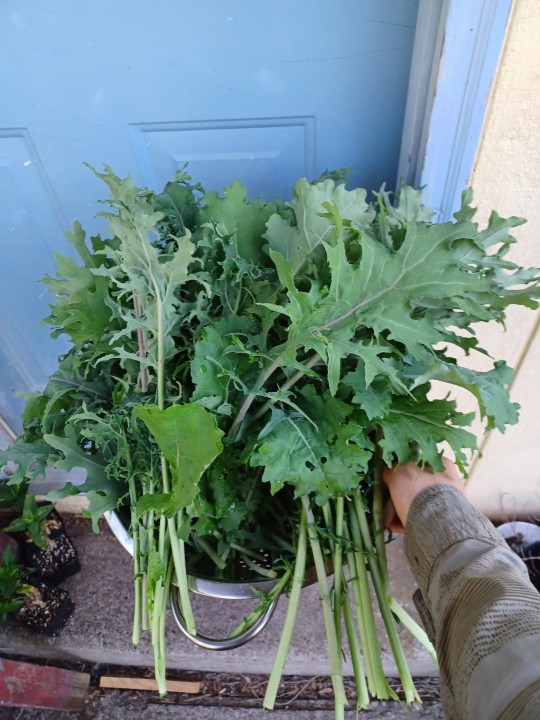
I'll keep making selections over the next year or so, removing from the gene pool any that are too bug eaten, or don't make it through winter, or bolt way early next spring.
Now, I'm not an expert here, and I'm doing this very casually, but I've been very happy with the results so far. If you want to learn more, I really liked Carol Deppe's book about breeding vegetables.
381 notes
·
View notes
Text

Oxfam experts, together with cocoa farmers, will be at the World Cocoa Conference in Brussels (21-24 April), taking place against a backdrop of unprecedented production shortfalls and skyrocketing cocoa prices, which topped $11,000 per metric ton for the first time.
Chocolate giants have already raised prices for consumers to offset rising cocoa costs and, despite years of soaring profits and massive payouts to shareholders, have consistently pushed back on anything that could reduce their profit margins. New Oxfam analysis has found:
- Lindt, Mondelēz, and Nestlé together raked in nearly $4 billion in profits from chocolate sales in 2023. Hershey’s confectionary profits totaled $2 billion last year.
- The four corporations paid out on average 97 percent of their total net profits to shareholders in 2023.
- The collective fortunes of the Ferrero and Mars families, who own the two biggest private chocolate corporations, surged to $160.9 billion during the same period. This is more than the combined GDPs of Ghana and Ivory Coast, which supply most cocoa beans.
Decades of low prices have made farmers poorer and hampered their ability to hire workers or invest in their farms, limiting bean yield. Old cocoa trees are particularly vulnerable to disease and extreme weather. Many farmers are abandoning cocoa for other crops, or selling their land to illegal miners.
Speaking ahead of the conference, Oxfam’s Policy Advisor Bart Van Besien said:
“It’s ironic —the cocoa price explosion could have been averted if corporations had paid farmers a fair price and helped them make their farms more resilient to extreme weather. And it’s hypocritical —chocolate giants are paying high prices now that the market demands it, but have pushed back every single time that cocoa farmers have. The only way forward is fairly rewarding farmers for their hard work.”
And Ismael Pomasi, Chairman of Ghana’s Cocoa Abrabopa Association, said:
"Nothing is more demotivating —all my hard work on the farm barely pays off. Between battling pests and the drought that is killing my cocoa trees, I'm really struggling. I wish I could afford irrigation. If the multibillion-dollar chocolate industry paid fair prices for cocoa, I could actually tackle these problems and make a decent living."
Oxfam spokespersons and farmers available for interviews in Brussels:Nana Kwasi Barning Ackay, project officer at SEND Ghana and Coordinator of the Ghana Civil Society Cocoa Platform (GCCP) (English)
Ismael Pomasi, Chairman of Ghana’s Cocoa Abrabopa Association (English)
Anouk Franck, Policy Advisor on Business and Human Rights, Oxfam Novib (Dutch, English)
Bart Van Besien, Policy Advisor, Oxfam Belgium (Dutch, English, French)
Key dates:
Oxfam spokespersons and farmers will come together to hand out chocolate produced by Ghana’s Women in Cocoa Cooperative (Cocoa Mmaa), and will be available for interviews and photos.
7:30-9:00am CET on 22 April at Place d’Albertine, in front of the World Cocoa Conference.
25 notes
·
View notes
Note
*sitting cross legged on your floor and hands you a cup of tea*
The ghouls working in agriculture/farm and ranch supply
Mountain is your seed agronomist/soil sciences expert. He's gonna tell you exactly what type of grass mix you want and when to plant it. You want to plant orchard grass in a fast draining sandy soil? No ma'am you need something hardier than that.
Dew and Swiss are in the back working the loading bay and the forklifts. Dew got teased and shit on for being so small and not being strong enough until he loaded an entire trailer bed with alfalfa bales by hand.
Rain is your irrigation expert. He can definitely tell you if you need center pivot irrigation or if you can get away with wheel lines. For the love of God, don't talk to him about over watering your lawn. Conserve water dammit!
Phantom is the new associate they put in charge of the rabbits, ducks and chicks during Chick Days. He's so sweet with them but he's had to be told multiple times that no, the kids cannot reach in to hold the animals.
Aether is in charge of the animal husbandry/veterinary supply section. He also helps with the quarterly spay/neuter pop up clinics that they host in the store.
Cumulus and Sunshine are in charge of the clothing section. They can tell you for sure what brands are more affordable but still just has sturdy as Carhartt. And no, that cut of boot cut jeans does not work for your body shape but we will find you something that makes you feel great and your ass look fabulous.
Aurora is in charge of the nursery section. Her plants are the healthiest and come with a life guarantee. She and Mountain work...very close together.
Cirrus is the store manager. She's fair, she runs a tight ship, but you better be respectful to her employees or she will ban your ass.
*takes the tea and slides you a plate of pastries*
Dew getting teased/people not thinking he's strong enough to do his job is highkey relatable, but also him hauling ass and getting shit done is very satisfying. (I have The Ballad of Smokin' Joe Rudeboy by Tom Cardy stuck in my head, and you just have to imagine Dew flipping Swiss off on the truck.)
He's probably also had to answer the question, "Is this first cut or second cut hay?" but no one has told him, and, hell, it could be third cut his late in the season-
His intuits it, and he's always right.
Also the image of Aether helping with the pop up clinics; How many times has he looked at the other guys passing by and joked, "That one's not up on his rabies shot, so look out!" and it's Mountain, who's busy carrying flowerpots, so he nudges Aurora to flip him off for him.
I feel like they all wind up dirty somehow, it just happens, but it's a gradient of filth.
On that note, today's one of my long day at the barn; It's seed restock day.
#lamp rambles#shitghosting#nameless ghouls#ghost band#the band ghost#ghost bc#ghost band headcanons#nameless ghoul headcanons#ask thingie#mac mac mac
38 notes
·
View notes
Text
Support Families in Northern Gaza through Rooftop & Home Vegetable Gardens
"My name is Laila El-Haddad. I'm an author and advocate for Palestinian rights and food justice. Many of you might know me as the co-author of The Gaza Kitchen: A Palestinian Culinary Journey. I'm also an avid gardener and though I am from Gaza City, I'm a farmer at heart! Farmers represent the deep rootedness Palestinians have to the land. For Palestinians, farming, especially during a time of genocide and ecocide-is an act of deep faith and the very embodiment of Sumood- the Palestinian concept of steadfast perseverance.
Background
Once known for its lush apple orchards, strawberries, and citrus, northern Gaza is now completely cut off from the rest of Gaza.
As part of its policy to make Gaza unlivable, Israel has destroyed 50% of Gaza's trees and farmland, and severely restricted the entry of food and aid, especially to the north. The scale of damage and destruction is catastrophic. Israeli forces have leveled agricultural land, 90% of all greenhouses, olive groves, and poultry farms. The entire population is now facing a forced starvation policy and experiencing extreme hunger.
Your Donation Will Help Change This Reality by Providing Rooftop, Home, and Urban Vegetable Gardens through seedling and seed distribution for Vulnerable and Displaced Families in Northern Gaza who are subsisting on 245 calories a day.
What and Why?
I'm organizing this campaign to help support farmers and families in the areas of northern Gaza most impacted by Israel's ongoing war to start their own rooftop and home gardens-a small step towards self sufficiency and food sovereignty. All international and local aid agencies have had to evacuate from the north, leaving the population especially vulnerable, and whatever limited amounts of fresh produce and aid are available are sold astronomical prices.
How?
I spent months researching and consulting with agricultural experts in Gaza and abroad on the most secure and effective way to give Palestinians sustainable access to fresh produce. Next, I partnered with with the Gaza Palestinian American Association and the Middle East Children's Alliance, both accredited 501(c)(3) who are taking 0% overhead, as well as a team of community based partners in Gaza, who will be sourcing the supplies needed to start the home gardens locally and managing the project.
Our team on the ground has been working hard to source and start growing local seedlings to distribute to families, and other materials needed to provide them with the resources they desperately need to start their own home, rooftop, patio, and community vegetable gardens, depending on the spaces they have access to. We will roll out the project in several phases, which each phase targeting 100 families.
Each family will receive:
* At least 30 assorted seasonal vegetables seedlings (Palestinian summer squash, hot peppers, eggplant, cucumber and tomatoes, depending on availability)
* 80 grams of local seeds (dill, mulukhiya, chard),
* Compost, soil, and amendments
* Plastic planters, irrigation cans, where needed
* Training and follow up by agriculture experts
Your donations will also help fund the purchase of several solar panel systems to power community wells that communities rely on to drink and irrigate their gardens and farms with (currently, municipal access to water is limited to once every ten days, and well motors are inoperable due to an Israeli ban on the entry of fuel).
With your support, we can help Palestinian families sow the seeds of a brighter future, cultivate hope and grow some of their own food again!
Your donation is tax deductible and zakat eligible! 100% of the proceeds will go towards the project in Gaza!
Together, we will help families in the north grow healthy food for themselves, their neighbors and their friends!
5 notes
·
View notes
Text
Apple Hills in Kitakami - How Realistic Is It?
I was playing pokemon violet and doing some shiny hunting in Kitakami, specifically in the Apple Hills, and while I was there it made me think. How realistic is the apple orchard compared to real life? I study horticulture and have taken a few classes on fruit and orchard production, so it sparked my curiosity.
(Just as a disclaimer, most of my knowledge of apple production comes from the United States rather than Japan, where Kitakami is based on. From what I read, most of the production is the same with a few minor differences. For example, most apple orchards in Japan are much smaller at a few acres while American apple orchards can be hundreds of acres. Also, I won’t claim to be an expert in apple production and if someone wants to correct me or add on feel free to. Most of this comes from my notes from different horticultural classes I have taken as well as university extension publications.)
Soils and Climate
Apples are temperate fruit crops but can grow within a wide range of latitudes depending on the variety grown, even subtropical areas if you manage it correctly. Kitikami is based on the Tohoku region of Japan, which is considered temperate. There is apple production in this area as well as Hokkaido and Nagano Prefecture.
In general, well drained and sloped land is preferable for temperate fruit crops like apples. Having the plant directly on top of a hill has better drainage and sunlight exposure, but is also exposed to more wind and weather that can damage the plant. Lowlands have issues with drainage and airflow, as cool air sinks and if it stays for a significant period of time it will cause freeze damage. The Apple Hills are located on a hill, true to their namesake, so this part is accurate.
Although irrigation isn’t a major factor in apple production as apples are fairly drought tolerant, it can be more convenient to locate an orchard near a water body. This is because larger water bodies help mitigate large temperature fluctuations and avoid spring freezes. I mention this because the Apple Hills are fairly close to a river, so it may or may not influence the production.
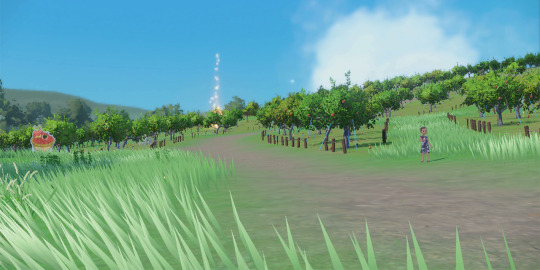
(From Bulbagarden)
Apple Tree Size and Structure
Different to popular belief, most apple trees in orchards are dwarfed. If left alone trees can get to 25 feet, but in some orchards they can be as small as 10 or even 8 feet tall. This dwarfing is done through a variety of techniques including using specific rootstocks, grafting, and training of the tree’s architecture. The trees within the Apple Hills are quite small, only reaching to about double the player’s height. Which isn’t that tall considering the player is still supposed to be a child, and that the average protagonist height is around 5 feet.
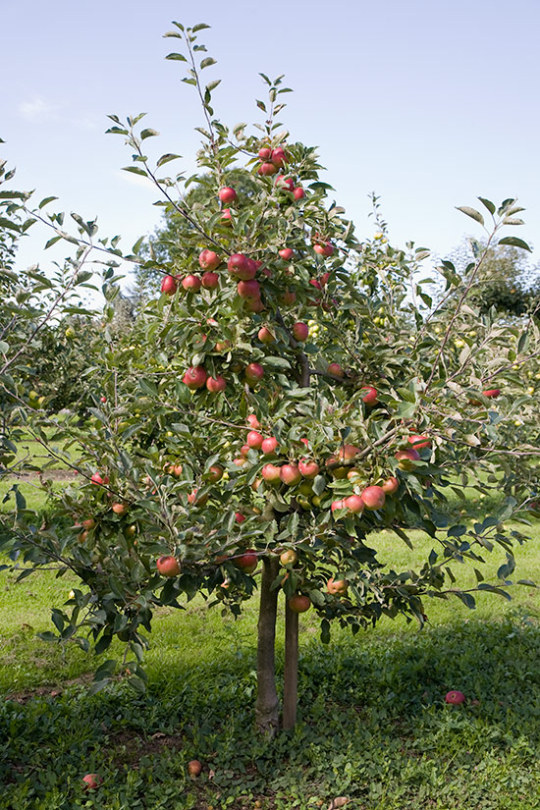
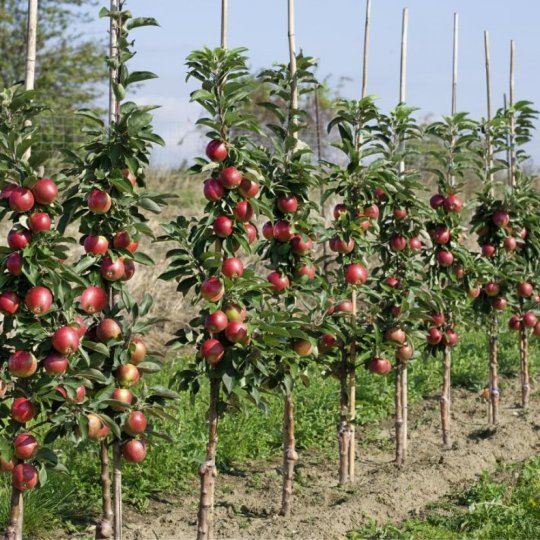
(Images from here and here)
The shape of apple trees can vary from orchard to orchard, but the two most common types are pyramidal with different tiers of branches or columnar. The pyramidal shape is usually done by training a central leader (or branch) to become the main branch and have the other horizontal branches become different tiers. This process makes for good light distribution into the canopy as well as restricting the growth somewhat. The columnar structure also helps with light distribution, but not as much as the pyramidal structure. However, the columnar structure helps with packing in more trees into an area and creates high density planting, which may increase total fruit yield. There is also a very thin structure called a spindle, which only has a canopy 1-2 feet in diameter and more cylindrical. They allow for easier harvesting and potentially more yield, but require support structures and more management The trees within the game have no one structure, some are wide and branched while others are more narrow. Although this isn’t accurate to real life, this is probably done for aesthetic purposes as to not make the orchard repetitive and boring for the player. The supports on the ground however are accurate as many trees are so small they need additional structures to help grow, otherwise the branches may snap off or the whole tree might fall over.
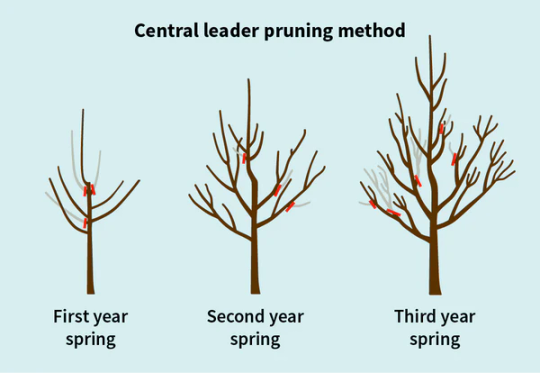
(Image from here)
Pokemon and Pests?
Some of the most prominent pests are codling moth, apple maggot, apple scab (fungal), and fire blight (bacterial). However, animals like birds and mammals can also be a problem. There are many different pokemon that spawn within the Apple Hills that may be considered pests, but I want to point out applin in particular. It’s based on ‘worms’ in apples (which in reality are the larvae or maggots of insects) and may be considered the biggest pest in the pokemon world. They eat and can disguise themselves as apples, potentially decreasing fruit quality and the total yield. But considering many trainers in Kitakami use applins in battle, it may also be a cultural icon that people love and will tolerate eating their apples. It may be true that a lot of the pokemon in the orchard will become pests, but considering the people of Kitakami live in harmony with pokemon and may find them cute, they could allow for some of the fruit to be eaten by pokemon while keeping the rest for themselves.

Taste of the Fruit
In a conversation in the League Club in the Blueberry Academy Amarys says in reference to the apples from Kitakami, “The high sugar content gives them a superb flavor”. In English the apples exclusive to Kitakami are called syrupy apples, while in Japan they are called honeycore apples. This is most likely in reference to honeycrisp apples, which are the most popular apple variety due to its crispy texture, sweetness, and juiciness. However, honeycrisp apples were bred for their taste rather than their ease of production. As such they are notorious for being hard to produce and require very specific conditions and maintenance in order for the tree to be productive enough to turn a profit. I don’t think this difficulty is the case within Kitakami since they grow so much and don’t have that much advanced equipment, but I would expect the taste to be similar to honeycrisp.


Sources:
4 notes
·
View notes